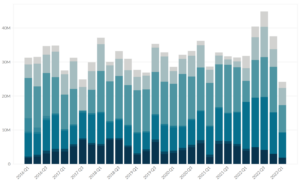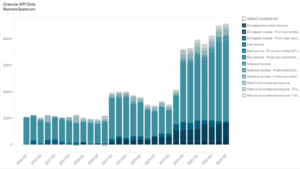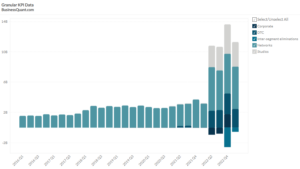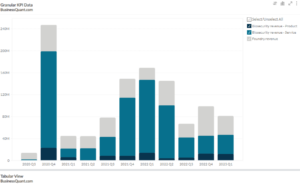
Caterpillar’s Revenue Breakdown by End-Market (2016-2023)
Exclusive Data
You need the Pro Plan to access KPI data
- Full access to the platform
- KPI data & segment financials on US stocks
- Financial data on thousands of stocks
- Download data in xlsx and csv formats
Pro Plan
$49 per month*
60% discount ends in:
.
About
More information
Subscribe to Pro or Enterprise plans to unlock this feature.
Contact the Analyst
Subscribe to Pro or Enterprise plans to unlock this feature.
Become a smarter investor today.
Access KPIs & Segment Financials on US stocks
This statistic highlights Caterpillar’s Revenue Breakdown by End-Market, split between Construction Industries, Energy & Transportation, Financial Products, and Resource Industries, reported on a quarterly basis from 2016 onwards
Caterpillar’s Revenue Breakdown by End-Market
| Segment | Q1 2021 | Q1 2020 | YoY Growth | Revenue share in Q1 2021 |
| Construction Industries | $5,441 | $4,312 | 26% | 46% |
| Energy & Transportation | $3,658 | $3,618 | 1% | 31% |
| Financial Products | $761 | $814 | -7% | 6% |
| Resource Industries | $2,097 | $1,979 | 6% | 18% |
| Total | $11,957 | $10,723 | 12% | 100% |
(All figures in millions, except percentages)
- Construction Industries: The Construction Industries segment helps customers in finding the ideal machinery in infrastructure, building construction, and forestry. In this segment, the majority of the sales are in heavy and general construction, aggregates markets, rental, quarry, and mining. In this segment, Caterpillar faces global competition from CASE, Deere Construction & Forestry, Volvo Construction Equipment, Hyundai Construction Equipment Co., Ltd., Doosan Infracore Co., Ltd., Kubota Farm & Industrial Machinery, Kobelco Construction Machinery, Hitachi Construction Machinery Co., Ltd., J.C. Bamford Excavators Ltd., and Komatsu Ltd. Whereas, its regional and specialized local competitors are Guangxi LiuGong Machinery Co., Ltd., Shantui Construction Machinery Co., Ltd., XCMG Construction Machinery Co., Ltd., Longking Holdings Ltd., Shandong Lingong Construction Machinery Co., Ltd., and Sany Heavy Industry Co., Ltd.Caterpillar’s Construction Industries product portfolio includes the following machines, related parts, and work tools: road reclaimers, skid steer loaders, pipelayers, forestry excavators, motor graders, site prep tractors, telehandlers, asphalt pavers, compactors, compact track, mini, small, medium and large excavators, backhoe loaders, cold planers, multi-terrain loaders, small and medium track-type tractors, track-type loaders, compact, small and medium wheel loaders, wheel excavators, and utility vehicles.In Q1 2021, Caterpillar generated approximately 46% of total revenue from this segment amounting to $5.44 billion. The revenue from this segment has increased by 26% year-over-year from $4.31 billion in Q1 2020. This increase in revenue was due to higher sales volume driven by higher end-user demand and due to an increase in dealer’s inventories.
- Energy & Transportation: The Energy & Transportation segment offers oil and gas, marine, power generation, rail, and industrial applications. The competitive environment includes larger global competitors like Rolls-Royce Power Systems, Deutz AG, Cummins Inc., INNIO, and Wärtsilä Corp, MAN Energy Solutions (VW), Siemens Power & Gas, Fiat Industrial SpA, Kawasaki Heavy Industries Energy System & Plant Engineering, Kohler Power Systems, Alstom SA, CRRC Corp., LTD., Weichai Power Co., Ltd., Mitsubishi Heavy Industries Ltd., GE Power, Volvo Penta AB, Aggreko plc, Baker Hughes Co., Generac Holdings, Vossloh AG, The Greenbrier Companies, Siemens Mobility, Voestalpine AG, and Wabtec Freight.Caterpillar’s Energy & Transportation portfolio includes the following products and related parts: Turbines, centrifugal gas compressors & related services, Reciprocating engines supplied to the industrial industry as well as Caterpillar machinery, Remanufactured reciprocating engines and components, Reciprocating engines, and integrated systems and solutions for the marine and oil and gas industries, Reciprocating engine-powered generator sets, Diesel-electric locomotives, including components &other rail-related products and services, and Integrated systems used in the electric power generation industry. In Q1 2021, Energy & Transportation’s total revenue was $3.66 billion, an increase of 1% year-over-year, compared with $3.62 billion in Q1 2020. Revenue growth was driven by Power Generation and Oil and Gas, partially offset by a decrease in Transportation.
- Financial Products: Revenue in this segment is generated by Cat Financial, Insurance Services, and their respective subsidiaries and affiliates. Cat Financial provides retail and wholesale financing to dealers as well as customers around the world for financing for vehicles, power generation facilities, marine vessels, and other Caterpillar products. Retail financing comprises instalment sale contracts and other equipment-related loans, finance leases, working capital loans, and operating leases. On the other hand, wholesale financing consists of inventory and rental fleet financing. The majority of Cat Financial’s activity is conducted in North America followed by Latin America, Asia/Pacific, Europe, Africa, and the Middle East. Cat Financial operates in a highly competitive environment facing competition from a variety of sources, principally commercial banks and finance and leasing companies. Cat Financial’s competitors are Banc of America Leasing & Capital LLC, Australia and New Zealand Banking Group Limited, Wells Fargo Equipment Finance Inc., BNP Paribas Leasing Solutions Limited, Societe General, John Deere Capital Corporation, Volvo Financial Services, Komatsu Financial L.P., and Kubota Credit Corporation.Caterpillar Insurance Company, a wholly-owned subsidiary of Caterpillar Insurance Holdings Inc., is licensed to conduct property and casualty insurance business. Caterpillar Life Insurance conducts life, health, and accident insurance business. Caterpillar Life Insurance Company has also entered into a reinsurance agreement with Caterpillar Insurance Company, assuming 100% of the risk of an Accident and Health Stop Loss Insurance Policy to cover a Caterpillar Voluntary Employees’ Benefits Association (VEBA) Trust for medical losses born by a select group of Caterpillar retirees and dependents.In Q1 2021, Financial Products’ segment revenues were $761 million, a decrease of 7% from $814 million in Q1 2020. This decrease in revenue was primarily because of lower average financing rates and lower average earning assets in North America.
- Resource Industries: The Resource Industries segment offers machinery in mining, heavy construction, and quarry, and aggregates. Caterpillar develops high productivity equipment for surface as well as underground mining operations around the world. It also provides drivetrains, electronics, hydraulic systems, and software for Cat machines and engines. The equipment is used to extract and haul copper, oil sands, iron ore, coal, gold, aggregates, and other minerals and ores.Caterpillar’s Resource Industries faces competition from larger global competitors like Deere Construction & Forestry, Liebherr-International AG, Hitachi Construction Machinery Co., Ltd., Komatsu Ltd., Sandvik AB, Epiroc AB, and Volvo Construction Equipment. Is product portfolio in this segment includes the following machines and related parts: hydraulic shovels, large wheel loaders, soil compactors, autonomous ready vehicles and solutions, articulated trucks, hard rock vehicles, large track-type tractors, wheel tractor scrapers, select work tools, landfill compactors, longwall miners, draglines, electric rope shovels, wheel dozers, and large mining trucks.In Q1 2021, Resource Industries’ revenue was $2.10 billion which increased by 6% year-over-year from $1.98 billion in Q1 2020. This increase was due to higher sales volume driven by the impacts of an increase in dealer inventories, higher end-user demand for equipment, and a favourable currency impact from the Australian dollar.
Company Overview
Caterpillar Inc. is an American-based company established in 1925 by C.L. Best. Its headquarters is in Illinois, U.S. Caterpillar’s common stocks are traded on the New York Stock Exchange under the trading symbol “CAT”.
Caterpillar is the world’s largest construction equipment manufacturer that manufactures, develops, engineers, markets, and sells machinery, financial products, engines, and insurance to customers through a worldwide network of dealers. Over the years, Caterpillar has acquired Trackson, Towmotor Corporation, Balderson, Inc., Barber-Greene Co. Inc., F.G. Wilson, Earthmoving Equipment Division, Caterpillar Elphinstone, Sabre Engines Ltd., Bitelli SpA, Wealdstone Engineering Ltd., Williams Technologies, Inc., Turbomach SA, Hindustan PowerPlus Ltd., Forestry Division of Blount International, Inc., Shandong Engineering Machinery (SEM), Lovat Inc., Shin Caterpillar Mitsubishi Ltd., Gremada Industries, Inc., Marble Robot, Inc., CleanAIR Systems, Inc., Caterpillar Xuzhou Ltd, Underground Imaging Technologies, Inc. (UIT), FCM Rail Ltd., JCS Co., Ltd., Twin City Signal Inc., etc. It faces competition from Westinghouse Air Brake, Hyundai Heavy Industries Holdings (HHI), KOBELCO, Allison Transmission, Scania, Aggreko, Liebherr Group, Cummins, and CNH Industrial.
Did you like Caterpillar’s Revenue Breakdown by End-Market statistic?
Access thousands of more such key performance indicator data points, on listed companies, with Business Quant.
You can also get started for free.
More data on US Stocks

Our Plans
Always know what you’ll pay. No hidden costs or surprises.
- Annual
- Monthly
60% discount till April 30
Pro
For serious investing
-
Company KPI data Access segment financials, non-GAAP metrics and KPI data from presentations and filings. Examples include financials by segment / region / product category, AT&T's broadband subscriber trends, Tesla's deliveries by model and lots more.
-
Stock research tools Features include : stock screener, stock comparison, industry financials, stock warnings, advanced charting tools, timeseries tables, scatter charts, financial statements, stock reports, SEC filings, stock ratings, institutional and insider ownership data. There are 200+ financial items and ratios on thousands of US stocks.
-
Industry data & tools Access premium operating data on 40+ industries. Examples include market share, smartphone shipments by vendor, subscribers by wireless carrier, historical gold production. There are 20,000+ such statistics.
Enterprise
For tailored workflows
-
All of Pro plan Get unfettered access to all our dashboards and dossiers.
-
Custom built features Get tailored dashboards built specially for you , based on your set of requirements, to simplify your research workflow.
-
Admin billing Back-end documentation support and multi-seat licensing.
* Billed annually, local taxes extra.
60% discount on Annual plan
Pro
For serious investing
-
Company KPI data Access segment financials, non-GAAP metrics and KPI data from presentations and filings. Examples include financials by segment / region / product category, AT&T's broadband subscriber trends, Tesla's deliveries by model and lots more.
-
Stock research tools Features include : stock screener, stock comparison, industry financials, stock warnings, advanced charting tools, timeseries tables, scatter charts, financial statements, stock reports, SEC filings, stock ratings, institutional and insider ownership data. There are 200+ financial items and ratios on thousands of US stocks.
-
Industry data & tools Access premium operating data on 40+ industries. Examples include market share, smartphone shipments by vendor, subscribers by wireless carrier, historical gold production. There are 20,000+ such statistics.
Enterprise
For tailored workflows
-
All of Pro plan Get unfettered access to all our features.
-
Custom built features Get tailored dashboards built specially for you , based on your set of requirements, to simplify your research workflow.
-
Admin billing Back-end documentation support and multi-seat licensing.
* Local taxes extra.






